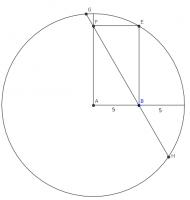Puzzles
Odd sums
What is \(\frac{1+3}{5+7}\)?
What is \(\frac{1+3+5}{7+9+11}\)?
What is \(\frac{1+3+5+7}{9+11+13+15}\)?
What is \(\frac{1+3+5+7+9}{11+13+15+17+19}\)?
What is \(\frac{\mathrm{sum\ of\ the\ first\ }n\mathrm{\ odd\ numbers}}{\mathrm{sum\ of\ the\ next\ }n\mathrm{\ odd\ numbers}}\)?
Show answer & extension
Hide answer & extension
They are all equal to one third.
The sum of the first \(n\) odd numbers is \(n^2\) (this can be proved by induction). This means that:
$$\frac{\mathrm{sum\ of\ the\ first\ }n\mathrm{\ odd\ numbers}}{\mathrm{sum\ of\ the\ next\ }n\mathrm{\ odd\ numbers}}=\frac{n^2}{(2n)^2-n^2}\\
=\frac{n^2}{3n^2}=\frac{1}{3}$$
Extension
What is \(\frac{\mathrm{sum\ of\ the\ first\ }n\mathrm{\ odd\ numbers}}{\mathrm{sum\ of\ the\ first\ }n\mathrm{\ even\ numbers}}\)?
Two lines
Let A and B be two straight lines such that the gradient of A is the y-intercept of B and the y-intercept of A is the gradient of B (the gradient and y-intercept of A are not the same). What are the co-ordinates of the point where the lines meet?
Show answer & extension
Hide answer & extension
Let A have the equation \(y = mx + c\). B will have the equation \(y = cx + m\).
Therefore, \(mx + c = cx + m\).
Which rearranges to \(x(m - c) = m - c.\)
So \(x = 1\).
Substituting back in, we find \(y=m+c\).
The co-ordinates of the point of intersection are \((1,m+c)\).
Extension
Let \(a\), \(b\) and \(c\) be three distinct numbers. What can you say about the points of intersection of the parabolas:
$$y = ax^2 + bx + c\mathrm{,}\\
y = bx^2 + cx + a\mathrm{,}\\
\mathrm{and\ }y = cx^2 + ax + b$$
x to the power of x
If \(x^{x^{x^{x^{...}}}}\) [\(x\) to the power of (\(x\) to the power of (\(x\) to the power of (\(x\) to the power of ...))) with an infinite number of \(x\)s] is equal to 2, what is the value of \(x\)?
arccos + arcsin
What is the value of \(\arccos(x) + \arcsin(x)\)?
Show answer & extension
Hide answer & extension
Let \(y = \arccos(x)\)
This means that \(x = \cos(y)\)
This gives us this triangle, as cosine is adjacent ÷ hypotenuse.
Call the angle at the top of the triangle \(z\).
Sine is opposite ÷ hypotenuse, so \(\sin(z) = x\)
So \(z = \arcsin(x)\)
Angles in triangle add to \(\pi\), so \(z = \frac{\pi}{2}-y\)
Hence, \(\arcsin(x)= \frac{\pi}{2}-y\)
Therefore \(\arccos(x) + \arcsin(x) = y + \frac{\pi}{2}-y\) \(=\frac{\pi}{2}\)
Extension
What are the values of \(\mathrm{arcsec}(x) + \mathrm{arccosec}(x)\) and \(\arctan(x) + \mathrm{arccot}(x)\)?
Twenty
How many three digit integers are there for which the product of the digits is 20?
Show answer & extension
Hide answer & extension
There are two ways to make 20 by multiplying three digits: \(2\times 2\times 5\) and \(1\times 4\times 5\). Listing all the possible orderings of these, we have:
145
154
415
451
514
541
225
252
522
Therefore, there are 9 different three digit numbers where the product of the digits is 20.
Extension
How many 4 digit numbers are there where the product of the digits is 20?
5 digit?
\(n\) digit?
Colliding parallel people
If two people stand 1km apart and walk in the same direction, how far will the have to walk until they collide due to the curvature of the Earth? (diameter of Earth = 12,742km)
Show answer & extension
Hide answer & extension
By walking in a straight line, the people will follow a
great circle. They begin by travelling parallel to each other, so the 1km they are apart at the start is the furthest they will be apart. They will be 1km apart again after walking half way around the world and will collide at one quarter and three quarters of the way around.
Hence, each person will walk one quarter of the circumference of the Earth before colliding, which will be 10,018km.
Another way to see that this is the answer is to assume that the people stand on the equator and walk North. They will meet at the North Pole, one quarter of the way round.
Extension
If two people stand 10km apart and walk in the same direction, how far will the have to walk until they collide due to the curvature of the Earth? (diameter of Earth = 12,742km)




